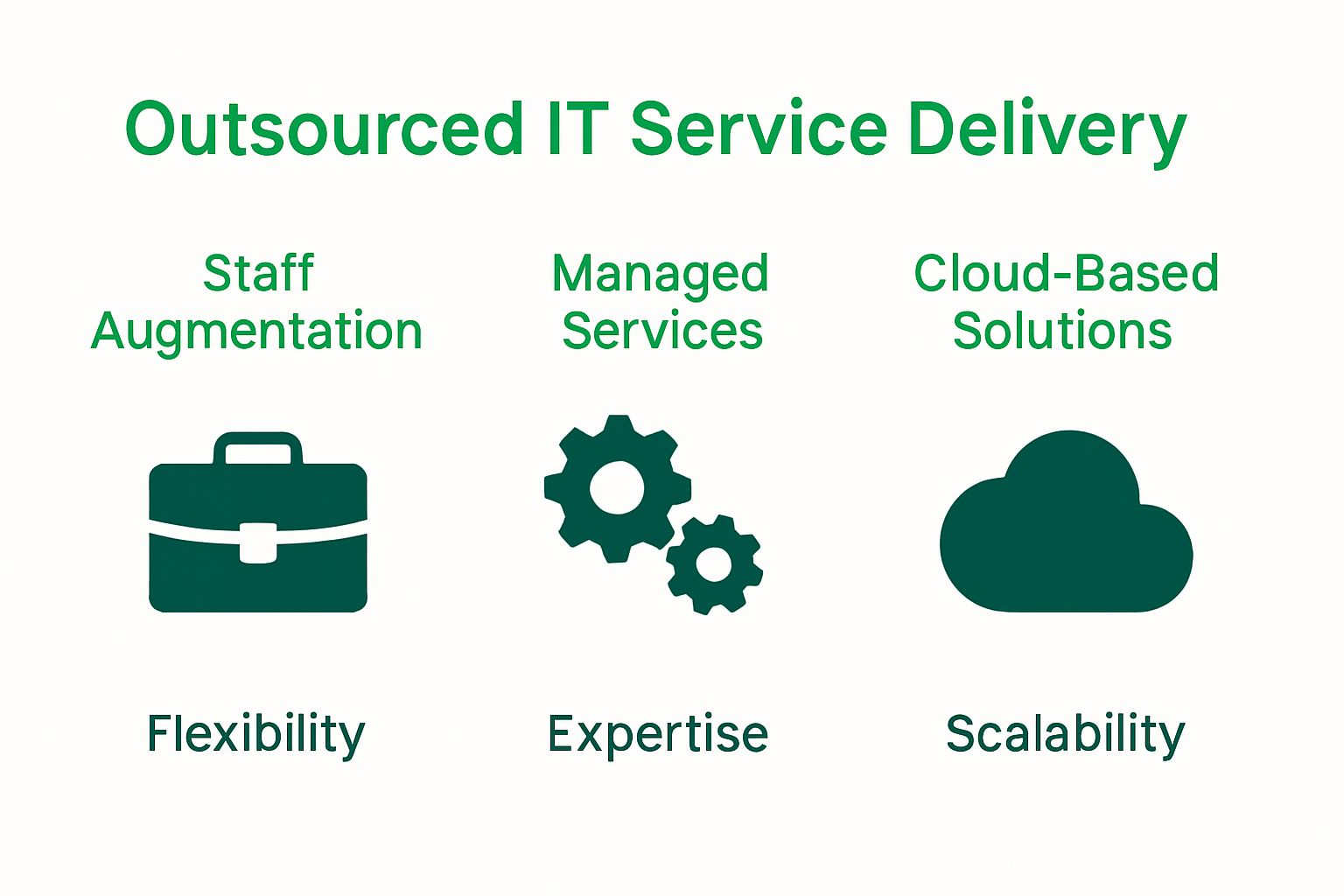Outsourced IT is changing the way businesses tackle technology needs. Companies that adopt this approach can cut their technology expenses by up to 30 percent, according to the U.S. Government Accountability Office. It might sound like just another way to save money, but the real surprise is how outsourced IT helps even small teams compete with giants, giving everyone access to top-level tech talent and innovation without hiring a massive internal staff.
Quick Summary
| Takeaway | Explanation |
|---|---|
| Outsourced IT boosts operational efficiency | By leveraging specialized expertise, businesses can enhance productivity and streamline operations without heavy internal investments. |
| Flexible resource allocation is key | Outsourcing allows companies to allocate resources to core tasks while scaling technology according to evolving needs. |
| Access to cutting-edge technology | Organizations can utilize advanced technological capabilities without undertaking extensive internal training or infrastructure costs. |
| Transforms fixed costs into variable expenses | Transitioning to outsourced IT helps firms better manage budgets and eliminates substantial upfront technology expenditures. |
| Strategic partnerships enhance competitiveness | Collaborating with specialized providers enables businesses to remain agile and competitive in a rapidly changing digital environment. |
Defining Outsourced IT: What It Is
Outsourced IT represents a strategic business approach where organizations partner with external technology service providers to manage specific or comprehensive information technology functions. Unlike traditional in-house IT departments, outsourced IT allows companies to leverage specialized expertise while optimizing operational efficiency.
Core Components of Outsourced IT
At its fundamental level, what is outsourced IT encompasses a comprehensive range of technology services externally managed by specialized providers. These services can include network infrastructure management, cybersecurity monitoring, software development, technical support, cloud computing solutions, and system maintenance.
Key areas typically covered in outsourced IT arrangements include:
- Network Infrastructure Management: Handling hardware, software, servers, and connectivity requirements
- Cybersecurity Services: Implementing protective measures against digital threats
- Technical Support: Providing helpdesk and troubleshooting capabilities
- Strategic Technology Consulting: Offering guidance on technological investments and digital transformation
Strategic Benefits for Businesses
Businesses choose outsourced IT solutions for multiple compelling reasons. According to the U.S. Government Accountability Office, organizations can significantly reduce operational costs and access specialized technological expertise through strategic outsourcing arrangements.
By partnering with external IT service providers, companies gain flexibility in scaling technology resources, access to cutting-edge technological capabilities, and the ability to focus internal resources on core business objectives. This approach allows businesses to maintain technological competitiveness without substantial internal infrastructure investments.
The following table summarizes the core components commonly included in outsourced IT arrangements and the key business benefits associated with each component.
| Outsourced IT Component | Description | Key Business Benefit |
|---|---|---|
| Network Infrastructure Management | Handles hardware, software, servers, and connectivity | Reliable, scalable infrastructure |
| Cybersecurity Services | Implements protective measures against digital threats | Enhanced data protection and compliance |
| Technical Support | Provides helpdesk and troubleshooting capabilities | Rapid issue resolution and minimal downtime |
| Strategic Technology Consulting | Offers guidance on technology investments and innovation | Smarter decision-making, digital transformation |
| Cloud Computing Solutions | Manages remote infrastructure and software | Flexible, cost-effective scalability |
| System Maintenance | Ongoing management and updates of IT systems | Reduced risk, improved performance |
The decision to implement outsourced IT represents a nuanced strategic choice that goes beyond simple cost reduction. It involves creating a collaborative partnership that enables businesses to remain agile, technologically current, and operationally efficient in an increasingly complex digital landscape.
The Importance of Outsourced IT for Businesses
Outsourced IT has transformed from a tactical cost-cutting strategy to a critical business enabler that provides organizations with substantial competitive advantages. By leveraging external technological expertise, businesses can navigate complex digital landscapes more effectively and strategically.
Strategic Performance Enhancement
Businesses recognize outsourced IT as a powerful mechanism for performance optimization. According to research from the National Academies Press, outsourced IT helps organizations access specialized technological capabilities that might be challenging or expensive to develop internally.
Key performance advantages include:
- Rapid Technology Adaptation: Quick integration of emerging technologies
- Resource Allocation: Redirecting internal talent toward core business objectives
- Scalability: Flexible technological infrastructure that grows with business needs
Financial and Operational Benefits
Financial considerations play a significant role in driving outsourced IT adoption. Companies can transform fixed technology costs into variable expenses, enabling more predictable budgeting and reducing substantial upfront investments. Learn more about our IT support services for comprehensive technological management solutions.
By outsourcing IT functions, businesses gain access to advanced technological expertise without maintaining extensive in-house teams. This approach allows smaller organizations to compete with larger enterprises by accessing enterprise-grade technological capabilities at a fraction of the traditional investment cost.
Moreover, outsourced IT providers continuously update their skills and technological infrastructure, ensuring businesses remain technologically competitive without constant internal training and equipment investments. This dynamic approach enables organizations to focus on strategic growth while maintaining robust, secure, and efficient technological ecosystems.
How Outsourced IT Works: Key Mechanisms
Outsourced IT operates through sophisticated collaboration models that transform traditional technology management approaches. These mechanisms enable businesses to seamlessly integrate external technological expertise into their operational frameworks, creating dynamic and responsive IT ecosystems.
Service Delivery Models
According to the U.S. Department of Veterans Affairs, outsourced IT typically involves comprehensive contractual arrangements that precisely define service expectations, performance metrics, and technological responsibilities. These models range from project-based engagements to ongoing managed service partnerships.
This table compares common service delivery models used in outsourced IT, highlighting their definitions and ideal use cases for businesses seeking external IT support.
| Service Delivery Model | Definition | Ideal Use Case |
|---|---|---|
| Staff Augmentation | Supplementing internal teams with external IT professionals | Temporary skills gap or workload |
| Managed Services | Full external management of specific IT functions | Ongoing support for core IT systems |
| Cloud-Based Solutions | Management of infrastructure/software via remote cloud hosting | Need for scalability and flexibility |
| Project-Based | Short-term external support for defined initiatives | Specialized, outcome-driven projects |
Key service delivery approaches include:
- Staff Augmentation: Supplementing internal teams with specialized external professionals
- Managed Services: Complete external management of specific technological functions
- Cloud-Based Solutions: Remote infrastructure and software management
Operational Coordination Frameworks
Successful outsourced IT implementation relies on robust communication and governance structures. Explore our business process outsourcing solutions to understand comprehensive technological partnership strategies.
Typical coordination mechanisms involve establishing clear service level agreements (SLAs), defining precise performance indicators, and creating transparent reporting protocols. These frameworks ensure that external technology partners align closely with an organization’s strategic objectives, maintaining accountability and delivering consistent technological performance.

The mechanism goes beyond simple task delegation. It represents a strategic partnership where external providers become an extension of the internal technology ecosystem, bringing specialized expertise, advanced technological capabilities, and flexible resource management that adapts to evolving business requirements.
Understanding the Benefits of Outsourced IT
Outsourced IT transforms technological capabilities by providing businesses with strategic advantages that extend far beyond traditional cost reduction strategies. These benefits create comprehensive technological ecosystems that enable organizations to compete more effectively in rapidly evolving digital landscapes.
Operational and Strategic Advantages
According to research from the National Institutes of Health, outsourced IT increases operational efficiency through access to specialized professionals and industry best practices that might be challenging to develop internally.
Key operational benefits include:
- Enhanced Technological Expertise: Access to specialized skills without extensive recruitment
- Reduced Infrastructure Costs: Minimizing hardware and software investment expenses
- 24/7 Technical Support: Continuous technological monitoring and problem resolution
Financial and Competitive Transformation
Explore our cutting-edge web solutions to understand how technological partnerships can revolutionize business performance. Outsourced IT enables organizations to convert fixed technology expenses into flexible, scalable investments that adapt to changing business requirements.
Financial benefits extend beyond immediate cost savings. By leveraging external technological expertise, businesses can reallocate internal resources toward core strategic initiatives, fostering innovation and maintaining competitive advantage. This approach allows smaller organizations to access enterprise-grade technological capabilities without substantial upfront investments.
Moreover, outsourced IT providers consistently update their technological infrastructure and skills, ensuring businesses remain technologically current without continuous internal training and equipment upgrade expenses. This dynamic model represents a forward-thinking approach to technological management, enabling organizations to stay agile and responsive in an increasingly complex digital environment.
Real-World Applications of Outsourced IT
Outsourced IT solutions have become instrumental across diverse industries, enabling organizations to leverage specialized technological capabilities that drive operational efficiency and strategic innovation. These real-world applications demonstrate the transformative potential of strategic technological partnerships.

Industry-Specific Technology Management
According to the U.S. Government Accountability Office, federal agencies and private sector organizations increasingly rely on outsourced IT for complex technological requirements such as enterprise resource planning, cybersecurity monitoring, and cloud infrastructure management.
Key industry application areas include:
- Healthcare: Patient management systems and secure medical data infrastructure
- Finance: Cybersecurity, transaction processing, and regulatory compliance technologies
- Manufacturing: Supply chain management and industrial automation systems
Strategic Technology Implementation
Explore our software development capabilities to understand how targeted technological solutions can transform business operations. Outsourced IT enables organizations to implement sophisticated technological solutions without maintaining extensive in-house expertise.
For small and medium enterprises, outsourced IT provides access to enterprise-grade technological capabilities that would otherwise be financially prohibitive. Startups can quickly scale their technological infrastructure, while established businesses can modernize legacy systems through strategic external partnerships.
The versatility of outsourced IT extends beyond traditional support models. Modern technological partnerships involve collaborative ecosystem development, where external providers become integral strategic partners driving technological innovation and organizational transformation.
Ready to Transform Your Business with Outsourced IT?
If you have ever struggled with the challenge of keeping up with fast-moving technology, rising operational costs, or the need for specialized IT expertise, you are not alone. The article explained how outsourced IT can help you increase efficiency, reduce infrastructure headaches, and access proven technical support without the stress of managing an internal team. Imagine never having to worry about system downtime or outdated solutions. With Nine Archs, you gain access to cost-effective IT back office and support desk capabilities that keep your business running smoothly while you focus on your priorities.

Stop letting IT complexity limit your growth. Visit our website to explore how our Outsourced Virtual Assistants deliver scalable solutions for businesses that demand reliability and speed. Take the first step today. Ensure your technology works as hard as you do by reaching out for a tailored consultation. Your road to worry-free IT starts now.
Frequently Asked Questions
What is outsourced IT?
Outsourced IT refers to the strategic partnership between organizations and external technology service providers that manage various IT functions, enabling businesses to access specialized expertise and enhance operational efficiency.
What are the main benefits of outsourcing IT services?
The main benefits include cost savings, access to specialized technology skills, scalability of resources, and the ability to focus internal efforts on core business objectives while ensuring technological competitiveness.
How does outsourced IT improve business performance?
Outsourced IT enhances business performance by providing rapid technology adaptation, effective resource allocation, and scalable solutions that align with evolving business needs, ultimately leading to operational and financial transformation.
What types of services are typically included in outsourced IT?
Typical outsourced IT services include network infrastructure management, cybersecurity services, technical support, strategic technology consulting, and cloud-based solutions.










[…] their technology-related functions and processes to external specialized service providers. Understanding what is outsourced IT involves recognizing how companies can leverage external expertise to enhance technological […]
[…] Conversely, IT outsourcing involves partnering with external service providers who manage specific technological functions or entire technology departments. As defined by research, outsourcing is a “business practice in which companies use external providers to carry out business processes that would otherwise be handled internally” Understanding What is Outsourced IT for Businesses. […]